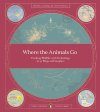Out of Print
By: James Cheshire(Author), Oliver Uberti(Author)
174 pages, colour illustrations, colour maps
![Where the Animals Go Where the Animals Go]()
Click to have a closer look
About this book
Biography
Related titles
About this book
Until the twentieth century, the study of animals was limited to what a naturalist could observe. 'Tracking animals' meant following their footprints and droppings. In 1900, scientists began the first bird-banding schemes and observation surveys. By the new millennium, researchers were using radio transmitters, drones, bioacoustics, DNA analysis, cellular networks and GPS to track wildlife. The authors highlight nine data-collection methods and create fifty stories around these, illustrated by stunning maps and graphics. From how birds avoid tornadoes to what slime can tell us about urban planning, Where the Animals Go will prove that ecology and zoology truly are tech fields.
Customer Reviews
Biography
Dr. James Cheshire is a geographer with a passion for London and big data. His award-winning maps have appeared in the Guardian and the Financial Times as well as on his popular blog, Mapping London. James is currently a lecturer at University College London and a Fellow of the Royal Geographical Society.
Oliver Uberti is a visual journalist, designer and the recipient of many awards for his information graphics and art direction. From 2003 to 2012, he worked in the design department of National Geographic, most recently as Senior Design Editor. He has a design studio in Ann Arbor, Michigan.
Out of Print
By: James Cheshire(Author), Oliver Uberti(Author)
174 pages, colour illustrations, colour maps
"[Where the Animals Go] is an enthralling volume, downright gorgeous in its illustrations and text. Its double intent is brilliant, too – to bring each of us closer to the animal world and to highlight fresh ways to think about conservation."
– Barbara King, NPR
"Where the Animals Go elegantly elucidates the role new technologies has played in expanding our knowledge of animal migration."
– Science
"Cheshire and Uberti write about billions of data points being collected – some by citizen scientists – and their ravishing maps put this information to good use [...] [They] show us with precision and clarity where the animals go."
– The Washington Post
"This book is beautiful as well as informative and inspiring. There is no doubt it will help in our fight to save wildlife and wild habitats."
– Jane Goodall
"In recent years, technology has made it possible to track animal movements from afar in more and more detail [...] [Cheshire and Uberti] have dipped into this deluge of data to create 50 beautiful and engaging maps that reveal the wanderings of animals."
– National Geographic
"A striking example of how innovative technology can be used to increase our understanding of the natural world."
– Financial Times
"This is a special kind of detective story. After millennia of using footprints, feces, feathers, broken foliage and nests to track animals, the process is now so teched up you need to read this book to find out the how, what and why."
– New Scientist
"[A] stunning translation of movement onto paper."
– Scientific American
"[W]ell laid out, easy to understand and a pleasure to return to many times."
– Seattle Times
"Some books cannot be read just once. Where the Animals Go [...] is a perfect example of that beloved book you find yourself returning to again and again. [...] Read it from start to finish or leave it on your coffee table and delve into whichever chapter strikes your fancy.[...]"
– Holly English, BES Bulletin 49(2), June 2018
"From the very first page this book is an enthralling look at the world that technology can help us uncover. It is not just a look at where the animals go, but why they are going, how the animals get there, the problems they encounter and the stories of some of these individuals. [...] I can’t review this book without mentioning the maps, which are exquisite. They convey an astounding quantity and quality of information, although much like the whole book they leave you wanting more. Perhaps this is the hallmark of a good book: it leaves you with more questions than you started with."
– Emily Scragg, BTO book reviews


































